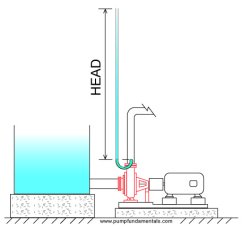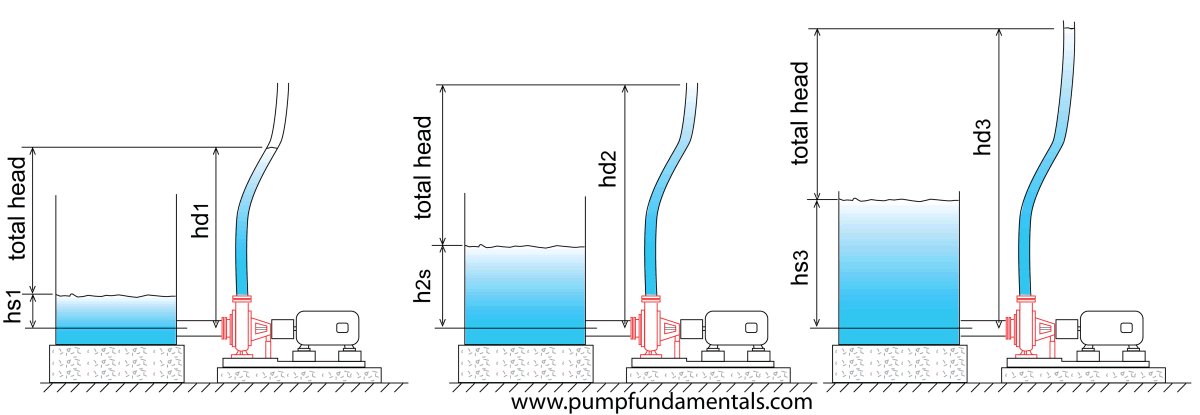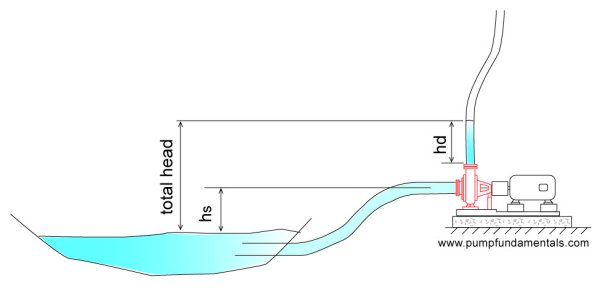Assume that you have a pump that you can disconnect the discharge pipe or tube and are able to extend it vertically. Head is the height at which a pump can raise water up, that's it, it's that simple.

Figure 2 The meaning of head.
Connect a tube to the discharge of a pump and measure the water height, that the head of the pump.
OK, so head is somehow linked to pressure, in what way? We will get to that later. For now let's agree to state that the more pressure the pump delivers the higher the head will be in the Figure 2.
Let's say the head we measure in the above situation is 60 ft (18 m), what happens to the head measured if the level in the suction tank is higher. Will the head measured be higher or lower?
If h2 is the head measured in Figure 2, will h3 be higher than h2 in Figure 3?

Figure 3 How discharge head varies with suction tank level.
The answer is yes.
If you lower the suction level the head measured will be less and the opposite is true if you raise it. That's all normal since the pump is just doing a mindless job and if you provide more energy to it in the form of more pressure at it's suction then that pressure increase will add to the pump's ability to produce pressure and create a higher water level at the discharge.
The pump manufacturer's want to tell you how much head their pump's will produce but they don't know what type of water supply will be available, so how can they get around this. Ingeniously simple, they subtract the head available at the suction from the head produced at the discharge, they call this Total Head. Then it doesn't matter what the suction tank level is, they are telling you only what the pump can do regardless of the water supply pressure at the suction.

Figure 4 Total head vs. discharge and suction head.
Total Head (HT) is:
HT = Hd -hs
So if you want to know what the discharge head is all you need to do is add the total head (HT) to the suction head hd.
OK smart guy, what if I don't have a tank and I'm pulling water from a lake and the lake is lower than my pump. Ha!

Figure 5 The effect of low level on the pump suction.
The pump will still produce the same total head but the discharge head will go down. This means you may not have enough pressure to run your devices and you may need to consider getting a pump with a higher total head.
When you buy a pump, you will try to find a pump that has the total head you require at the flow you require. In the example above the total head produced by the pump was at zero flow, nothing is coming out of the tube. Centrifugal pumps are like that, they can pump water up to a height and create pressure at the discharge without flow going through them; they are just sitting there churning up the same water. Note: it is not advisable to keep a pump running at zero flow for long periods of time. The total head at zero flow is the maximum head also called the shut-off head, the total head decreases as the flow increases. source:https://www.pumpfundamentals.com

Figure 2 The meaning of head.
Connect a tube to the discharge of a pump and measure the water height, that the head of the pump.
OK, so head is somehow linked to pressure, in what way? We will get to that later. For now let's agree to state that the more pressure the pump delivers the higher the head will be in the Figure 2.
Let's say the head we measure in the above situation is 60 ft (18 m), what happens to the head measured if the level in the suction tank is higher. Will the head measured be higher or lower?
If h2 is the head measured in Figure 2, will h3 be higher than h2 in Figure 3?

Figure 3 How discharge head varies with suction tank level.
The answer is yes.
If you lower the suction level the head measured will be less and the opposite is true if you raise it. That's all normal since the pump is just doing a mindless job and if you provide more energy to it in the form of more pressure at it's suction then that pressure increase will add to the pump's ability to produce pressure and create a higher water level at the discharge.
The pump manufacturer's want to tell you how much head their pump's will produce but they don't know what type of water supply will be available, so how can they get around this. Ingeniously simple, they subtract the head available at the suction from the head produced at the discharge, they call this Total Head. Then it doesn't matter what the suction tank level is, they are telling you only what the pump can do regardless of the water supply pressure at the suction.

Figure 4 Total head vs. discharge and suction head.
Total Head (HT) is:
HT = Hd -hs
So if you want to know what the discharge head is all you need to do is add the total head (HT) to the suction head hd.
OK smart guy, what if I don't have a tank and I'm pulling water from a lake and the lake is lower than my pump. Ha!

Figure 5 The effect of low level on the pump suction.
The pump will still produce the same total head but the discharge head will go down. This means you may not have enough pressure to run your devices and you may need to consider getting a pump with a higher total head.
When you buy a pump, you will try to find a pump that has the total head you require at the flow you require. In the example above the total head produced by the pump was at zero flow, nothing is coming out of the tube. Centrifugal pumps are like that, they can pump water up to a height and create pressure at the discharge without flow going through them; they are just sitting there churning up the same water. Note: it is not advisable to keep a pump running at zero flow for long periods of time. The total head at zero flow is the maximum head also called the shut-off head, the total head decreases as the flow increases. source:https://www.pumpfundamentals.com